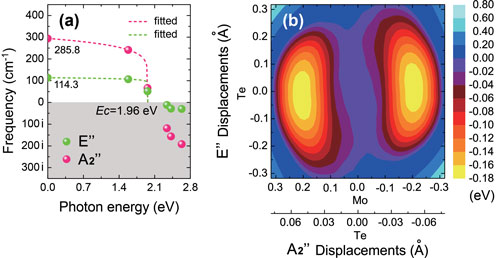| Sep 14, 2020 | |
Topological quantum phase in 2D MoTe2 induced by light |
|
| (Nanowerk Spotlight) A joint research team from Fudan University, Institute of Physics at Chinese Academy of Science, University of Cambridge, Wenzhou University, Shizuoka University, and Iowa State University has provided an example of on-demand control of quantum phenomena to design the quantum materials. | |
| By state-of-the-art quantum mechanical simulations, they find that a two-dimensional transition-metal ditelluride, MoTe2, can realize a structural phase transition from the semiconducting phase to the topological phase triggered by photoexcitation of carriers alone. The sub-picosecond phase transition can be controlled by varying the laser wavelength. | |
| The research work has been published in npj 2D Materials & Applications ("Sub-picosecond Photo-induced Displacive Phase Transition in Two-dimensional MoTe2"). | |
| Topological quantum matter exhibits exotic properties due to the entanglement properties of the wavefunction, providing new opportunities in areas ranging from energy management to low-power electronics, and to quantum computing. | |
| For instance, technology giants such as Microsoft are developing quantum computers based on topological quantum phase. For all these potential technological applications, it becomes desirable to explore ways of creating and manipulating topological quantum phases. | |
| However, the practical control of the topological properties is extremely hard. The difficulty lies in the unclear microscopic mechanism underlying the topological phase transition. | |
| For example, in the photo-induced topological phase transition in two-dimensional MoTe2 (Science, "Phase Patterning for Ohmic Homojunction Contact in MoTe2"), the system undergoes changes in temperature, strain, electronic excitation, chemical state, and lattice vibrational modes triggered by laser irradiation. The transition may depend on one of these factors or on a combination of them. | |
| Consequently, experimental optimization of these factors is time consuming and costly. Instead, we exploit computational techniques to model the quantum behavior of MoTe2 and investigate the microscopic mechanism virtually. This approach allows us to quickly explore the vast degrees of freedom to identify the most possible mechanism, and to accomplish this at a small cost compared to experiments. | |
| The research is inspired by the classical phase transition theory proposed by Lev Davidovich Landau and Rudolf Ernst Peierls. The Landau theory of phase transition attributes all structural phase transition to symmetry breaking controlled by the order parameter such as phonon displacement. | |
| The Peierls mechanism indicates that upon atomic displacement, a significant redistribution of the density of states occurs around the Fermi level, and lowers the total energy of the system. | |
| However, although such phenomena have been found in bulk materials with temperature-induced phase transition, it is unclear whether a photo-induced phase transition in two-dimensional materials can be understood in the framework of the classical theory of phase transition. | |
| The joint research team has revealed the underlying physics by simulating atomic displacements in the excited state to see whether (and how) a phase transition may be triggered. By promoting valence electrons from high-lying valence band states to low-lying conduction band states, they have calculated the potential energy surfaces along the phonon eigenvectors at different excitation energies. And by comparing the potential energy surfaces at different excitation energies, they have identified the correct microscopic mechanism. | |
| The photo-induced phase transition can be triggered by photoexcited carriers alone that soften multiple lattice vibrational modes. These softenings lead to structural symmetry breaking within sub-picosecond timescales, which is shorter than the timescale of a thermally driven phase transition. | |
| The transition is predicted to be triggered by photons with energies over 1.96 eV, which is confirmed by the soft-mode behavior under optical excitation described in the framework of Landau theory as shown in Figure 1. | |
| The microscopic picture of the phase transition is analogous to a Peierls distortion, with a red shift of the conduction bands that are occupied upon photoexcitation that lowers the overall energy of the system. Therefore, the transition mechanism under laser irradiation can be explained without introducing other factors such as local heat, thermal strain and Te vacancies. | |
 |
|
| Figure 1. Analysis of the E" and A2" modes. (a) Phonon frequency of the E" and A2" modes as a function of laser excitation energy. (b) Energy surface in the plane spanned by the two soft modes. (Image courtesy of the researchers) (click on image to enlarge) | |
| This research work provides an ultrafast mechanism to manipulate topological properties of 2D materials by varying the laser wavelength. Since the creation and manipulation of topological quantum phases are the main theme of on-demand control of quantum materials, it is expected that this work will inspire various follow-up theoretical and experimental efforts in topological switching for applications such as neuromorphic computing. | |
| ?In fact, promising results for controllable topological quantum materials have been obtained among the joint team and our collaborators,? said by Prof. Hao Zhang at Fudan University, ?Through these works, we aspire to outline a potential roadmap to an era of quantum phenomena on demand to design quantum materials of the future.? | |
|
Provided by Fudan University as a Nanowerk exlusive
|
|
|
Become a Spotlight guest author! Join our large and growing group of guest contributors. Have you just published a scientific paper or have other exciting developments to share with the nanotechnology community? Here is how to publish on nanowerk.com. |
|
